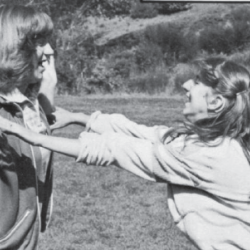Source Institutions
Source Institutions
Add to list Go to activity
Activity link broken? See if it's at the internet archive

In this set of outdoor games, learners play the role of monkeys that are trying to get enough resources (food, shelter, and space) to survive. They play several simple games which involve strength, quickness, coordination, intuition, and luck in order to acquire these resources. The games focus attention on the participants’ individual variations in these areas. There are three “rounds” which represent three different changing environments, each of which requires different skills for survival. After the games, learners compare who got enough resources and what variations among the players may have affected how the game went.
- 45 to 60 minutes
- 45 to 60 minutes
- Over $20 per group of students
- Ages 8 - 18
- Activity, Game, Lesson/Lesson Plan, Simulation
- English
Quick Guide
Materials List (per group of students)
- resource counters (popsicle sticks, cardboard pieces, other small objects)
- Games Monkey's Play Rules card (page 5 and 6 of PDF)
- watch or kitchen timer
- data board and marking pen
- two-meter lengths of heavy rope, old garden hose, etc.
- bolts, at least 5 cm long
- nuts to fit the bolts
- sewing needles
- corks
- spool of sewing thread
- 5" x 8" index cards
Subjects
-
Life Sciences
-
Diversity of Life
- Plants
- Animals
-
Ecology
- Populations
-
Human Body
- The Brain and Nervous System
- Muscles and Skin
-
Human Senses and Perception
- Touch
- Smell
- Perception
-
Diversity of Life
-
The Nature of Science
-
The Scientific Process
- Asking Questions
- Formulating Explanations
- Communicating Results
-
The Scientific Process
Informal Categories
- Animals
- Games
- Nature and Environment
- Outdoor Activity
- Physical Activity
- Sports and Exercise
Audience
To use this activity, learners need to:
- see
- be mobile
- touch
Learning styles supported:
- Involves teamwork and communication skills
- Involves hands-on or lab activities
Other
This resource is part of:
Access Rights:
- Free access
By:
Rights:
- All rights reserved, The Regents of the University of California, 1980
